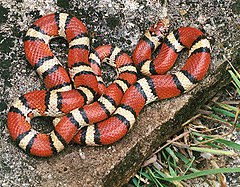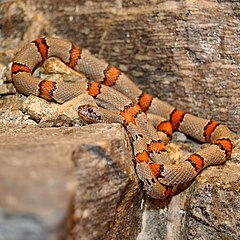Lampropeltis
| Lampropeltis[1] | |||
| Fitzinger, 1843[2] | |||
 Przedstawiciel rodzaju – lancetogłów mleczny (L. triangulum) w szacie młodocianej | |||
| Systematyka | |||
| Domena | eukarionty | ||
|---|---|---|---|
| Królestwo | zwierzęta | ||
| Typ | strunowce | ||
| Podtyp | kręgowce | ||
| Gromada | zauropsydy | ||
| Podgromada | diapsydy | ||
| Rząd | |||
| Podrząd | |||
| Infrarząd | Alethinophidia | ||
| Nadrodzina | Colubroidea | ||
| Rodzina | połozowate | ||
| Podrodzina | Colubrinae | ||
| Rodzaj | Lampropeltis | ||
| Typ nomenklatoryczny | |||
| Coluber getulus Linnaeus, 1766 | |||
| Synonimy | |||
| | |||
| Gatunki | |||
| |||
| |||
| |||

Lampropeltis – rodzaj węży z podrodziny Colubrinae w rodzinie połozowatych (Colubridae).
Zasięg występowania
Rodzaj obejmuje gatunki występujące w Kanadzie, Stanach Zjednoczonych, Meksyku, Gwatemali, Hondurasie, Nikaragui, Kostaryce, Panamie, Kolumbii i Ekwadorze[10].
Systematyka
Etymologia
- Lampropeltis: gr. λαμπρος lampros „błyszczący, świecący, lśniący”[11]; πελτη peltē „mała tarcza bez obramowania” (tj. łuska)[12].
- Ophibolus: gr. οφις ophis, οφεως opheōs „wąż”[13]; βολη bolē „strzała”[14]. Gatunek typowy: Ophibolus boylii Baird & Girard, 1853 (= Coluber (Ophis) californiae Blainville, 1835).
- Osceola: Hrabstwo Osceola, Floryda, Stany Zjednoczone, od Osceoli (1804–1838), północnoamerykańskiego Indianina z plemienia Krików, wodza Seminolów, podczas ich drugiej wojny z białymi Amerykanami[15]. Gatunek typowy: Coluber elapsoides Holbrook, 1838.
- Bellophis: łac. bellus „uroczy, zgrabny”[16]; gr. οφις ophis, οφεως opheōs „wąż”[13]. Gatunek typowy: Bellophis zonatus Lockington, 1876.
- Stilosoma: gr. στυλος stulos „kolumna, słup”[17]; σωμα sōma, σωματος sōmatos „ciało”[18]. Gatunek typowy: Stilosoma extenuatum Brown, 1890.
- Oreophis: gr. ορος oros, ορεος oreos „góra”[19]; οφις ophis, οφεως opheōs „wąż”[13]. Gatunek typowy: Oreophis boulengeri Dugès, 1897 (= Ophibolus triangulus mexicanus Garman, 1884).
- Stylophis: gr. στυλος stulos „kolumna, słup”[17]; οφις ophis, οφεως opheōs „wąż”[13]. Nowa nazwa dla Stilosoma Brown, 1890.
- Triaenopholis: gr. τριαινα triaina „trójząb”[20]; φολις pholis, φολιδος pholidos „rogowa łuska”[21]. Gatunek typowy: Triaenopholis arenarius Werner, 1924.
Podział systematyczny
Do rodzaju należą następujące gatunki[10]:
- Lampropeltis abnorma (Bocourt, 1886)
- Lampropeltis alterna (Brown, 1901) – lancetogłów szaropasy[22]
- Lampropeltis annulata Kennicott, 1860
- Lampropeltis californiae (Blainville, 1835)
- Lampropeltis calligaster (Harlan, 1827) – lancetogłów preriowy
- Lampropeltis catalinensis Van Denburgh & Slevin, 1921
- Lampropeltis elapsoides (Holbrook, 1838)
- Lampropeltis extenuata (Brown, 1890)
- Lampropeltis gentilis (Baird & Girard, 1853)
- Lampropeltis getula (Linnaeus, 1766) – lancetogłów królewski
- Lampropeltis greeri Webb, 1961
- Lampropeltis holbrooki Stejneger, 1902
- Lampropeltis knoblochi Taylor, 1940
- Lampropeltis leonis (Günther, 1893)
- Lampropeltis mexicana (Garman, 1884) – lancetogłów meksykański
- Lampropeltis micropholis Cope, 1860
- Lampropeltis nigra (Yarrow, 1882)
- Lampropeltis occipitolineata Price, 1987
- Lampropeltis polyzona Cope, 1860
- Lampropeltis pyromelana (Cope, 1866) – lancetogłów arizoński
- Lampropeltis rhombomaculata (Holbrook, 1840)
- Lampropeltis ruthveni Blanchard, 1920
- Lampropeltis splendida (Baird & Girard, 1853)
- Lampropeltis triangulum (Lacépède, 1789) – lancetogłów mleczny[22]
- Lampropeltis webbi Bryson, Dixon & Lazcano, 2005
- Lampropeltis zonata (Lockington, 1835) – lancetogłów koralowy
Przypisy
- ↑ Lampropeltis, [w:] Integrated Taxonomic Information System (ang.).
- ↑ L.J.F.J. Fitzinger: Systema reptilium. Fasciculus primus, Amblyglossae. Vindobonae: Braumüller et Seidel, 1843, s. 25. (łac.).
- ↑ Baird i Girard 1853 ↓, s. 92.
- ↑ Baird i Girard 1853 ↓, s. 133.
- ↑ W.N. Lockington. Description of a New Genus and Species of Colubrine Snake. „Proceedings of the California Academy of Sciences”. 7 (1876), s. 52, 1877. (ang.).
- ↑ A.E. Brown. On a new genus of Colubridae from Florida. „Proceedings of the Academy of Natural Sciences of Philadelphia”. 42, s. 199, 1890. (ang.).
- ↑ A. Dugès. Description d’un ophidien nouveau du Mexique (Oreophis boulengeri, g. et sp. nn.). „Proceedings of the Zoological Society of London”. 65, s. 284, 1897. (fr.).
- ↑ Ch. Berg. Herpetological Notes. „Comunicaciones del Museo nacional de Buenos Aires”. 1 (8), s. 290, 1901. (ang.).
- ↑ F. Werner. Neue oder wenig bekannte Schlangen aus dem Naturhistorischen Staatsmuseum in Wien. „Sitzungsberichte. Abt. 1, Mineralogie, Botanik, Zoologie, Paläontologie, Geologie, physische Geographie, Anatomie, Physiologie und theoretische Medizin”. 133, s. 50, 1924. (niem.).
- ↑ a b P. Uetz & J. Hallermann: Genus: Lampropeltis. The Reptile Database. [dostęp 2019-03-28]. (ang.).
- ↑ Jaeger 1944 ↓, s. 119.
- ↑ Jaeger 1944 ↓, s. 165.
- ↑ a b c d Jaeger 1944 ↓, s. 154.
- ↑ Jaeger 1944 ↓, s. 33.
- ↑ osceola, [w:] The Key to Scientific Names, J.A.J.A. Jobling (red.), [w:] Birds of the World, S.M. Billerman et al. (red.), Cornell Lab of Ornithology, Ithaca [dostęp 2021-12-27] (ang.).
- ↑ Jaeger 1944 ↓, s. 31.
- ↑ a b Jaeger 1944 ↓, s. 224.
- ↑ Jaeger 1944 ↓, s. 215.
- ↑ Jaeger 1944 ↓, s. 155.
- ↑ Jaeger 1944 ↓, s. 241.
- ↑ Jaeger 1944 ↓, s. 172.
- ↑ a b Praca zbiorowa: Zwierzęta: encyklopedia ilustrowana. Warszawa: Wydawnictwo Naukowe PWN, 2005, s. 403. ISBN 83-01-14344-4.
Bibliografia
- S.F. Baird & Ch.F. Girard: Catalogue of North American reptiles in the Museum of the Smithsonian institution. Cz. 1: Serpents. Washington: Smithsonian Institution, 1853, s. 1–172. (ang.).
- Edmund C.E.C. Jaeger Edmund C.E.C., Source-book of biological names and terms, wyd. 1, Springfield: Charles C. Thomas, 1944, s. 1–256, OCLC 637083062 (ang.).
- NKC: ph541616
- Britannica: animal/king-snake









